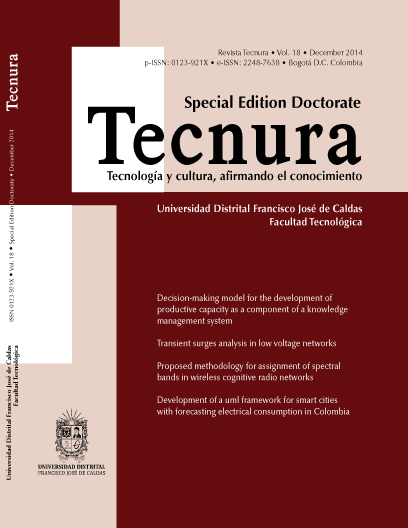DOI:
https://doi.org/10.14483/22487638.9246Publicado:
01-12-2014Número:
Vol. 18 (2014): Special Edition DoctorateSección:
InvestigaciónAutomation of functional annotation of genomes and transcriptomes
Palabras clave:
Annotator, Functional annotation, Gene ontology, High Throughput Sequencing. (en).Palabras clave:
Annotator, Functional annotation, Gene ontology, High Throughput Sequencing. (es).Descargas
Resumen (en)
Functional annotation represents a means to investigate and classify genes and transcripts according to their function within a given organism.
This paper presents Massive Automatic Functional Annotation (MAFA - Web), which is an online free bioinformatics tool that allows automation, unification and optimization of functional annotation processes when dealing with large volumes of sequences. MAFA includes tools for categorization and statistical analysis of associations between sequences. We have evaluated the performance of MAFA with a set of data taken from Diploria-Strigosatranscriptome (using an 8-core computer, namely E7450 @ 2,40GHZ with 256GB RAM), processing rates of 2,7 seconds per sequence (using Uniprot database) and 50,0 seconds per sequence (using Non-redundant from NCBI database) were found together with particular RAM usage patterns that depend on the database being processed (1GB for Uniprot database and 9GB for Non-redundant database).. Aviability: https://github.com/BioinfUD/MAFA.
Resumen (es)
Functional annotation represents a means to investigate and classify genes and transcripts according to their function within a given organism.
This paper presents Massive Automatic Functional Annotation (MAFA - Web), which is an online free bioinformatics tool that allows automation, unification and optimization of functional annotation processes when dealing with large volumes of sequences. MAFA includes tools for categorization and statistical analysis of associations between sequences. We have evaluated the performance of MAFA with a set of data taken from Diploria-Strigosatranscriptome (using an 8-core computer, namely E7450 @ 2,40GHZ with 256GB RAM), processing rates of 2,7 seconds per sequence (using Uniprot database) and 50,0 seconds per sequence (using Non-redundant from NCBI database) were found together with particular RAM usage patterns that depend on the database being processed (1GB for Uniprot database and 9GB for Non-redundant database). Aviability: https://github.com/BioinfUD/MAFA.
Referencias
Altschul, S. F., Gish, W., Miller, W., Myers, E. W., &Lipman, D. J. (1990). Basic local alignment search tool. Journal of molecular biology, 215(3), 403-410.
Ashburner, M., Ball, C. A., Blake, J. A., Botstein, D., Butler, H., Cherry, J. M., ...& Sherlock, G. (2000). Gene Ontology: tool for the unification of biology. Nature genetics, 25(1), 25-29.
Bairoch, A., Apweiler, R., Wu, C. H., Barker, W. C., Boeckmann, B., Ferro, S., ...&Yeh, L. S. L. (2005). The universal protein resource (UniProt). Nucleic acids research, 33(suppl 1), D154-D159
Camacho, C., Coulouris, G., Avagyan, V., Ma, N., Papadopoulos, J., Bealer, K., &Madden, T. L. (2009). BLAST+: architecture and applications. BMC bioinformatics, 10(1), 421.
Carbon, S., Ireland, A., Mungall, C. J., Shu, S., Marshall, B., & Lewis, S. (2009). AmiGO: online access to ontology and annotation data. Bioinformatics, 25(2), 288-289.
Cock, P. J., Antao, T., Chang, J. T., Chapman, B. A., Cox, C. J., Dalke, A., ...& de Hoon, M. J. (2009). Biopython: freely available Python tools for computational molecular biology and bioinformatics. Bioinformatics, 25(11), 1422-1423.
Metzker, M. L. (2010). Sequencing technologies—the next generation. Nature Reviews Genetics, 11(1), 31-46.
Pruitt, K. D., Tatusova, T., &Maglott, D. R. (2007). NCBI reference sequences (RefSeq): a curated non-redundant sequence database of genomes, transcripts and proteins. Nucleic acids research, 35(suppl 1), D61-D65.
Cómo citar
APA
ACM
ACS
ABNT
Chicago
Harvard
IEEE
MLA
Turabian
Vancouver
Descargar cita
Licencia
Esta licencia permite a otros remezclar, adaptar y desarrollar su trabajo incluso con fines comerciales, siempre que le den crédito y concedan licencias para sus nuevas creaciones bajo los mismos términos. Esta licencia a menudo se compara con las licencias de software libre y de código abierto “copyleft”. Todos los trabajos nuevos basados en el tuyo tendrán la misma licencia, por lo que cualquier derivado también permitirá el uso comercial. Esta es la licencia utilizada por Wikipedia y se recomienda para materiales que se beneficiarían al incorporar contenido de Wikipedia y proyectos con licencias similares.


